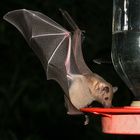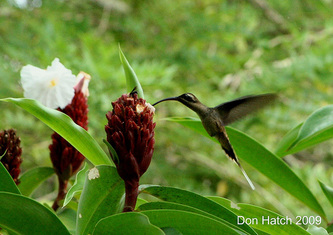 TRENT'S WALK IN THE BELIZEAN JUNGLE (Part Six) Is brought to you by "Grand Belizean Estates" the next place to call home.  HUMMINGBIRD SIGHTING My Grandpa Smith loves hummingbirds. He spends hours watching and feeding them at the family cabin. He has become quite the hummingbird caretaker of the Colorado mountains. It seems like every hummingbird in the world shows up at his front door for a sip of his sugar juice and then from his cabin, they migrate down to Belize. Grandpa Smith has multiple feeders like the one to the left, going all day long at the cabin. There are times, when he has to stop several times A DAY! and mix up more sugar juice, for these little guys. He now buys his sugar in large sacks, at Costco and Super Buy. GRANDPA SMITH'S HUMMINGBIRD ENERGY DRINK: The Official "Smith Recipe" Four parts water to one part white sugar. (For example, 1/4 cup of sugar stirred into 1 cup of water.) Tap or well water is preferred; do not use distilled as it takes out too many naturally occurring minerals. If you use a water softener, you may want to use partial or totally filtered water; softeners may add too many minerals and salts to the water. Room Temperature Method: Use very warm water (not hot) right out of the tap. Some brisk stirring is all that is required to dissolve the sugar. Let it cool a bit before setting out a feeder if the sugar water is hot to the touch. Sugar solution can be made ahead and kept up to a week in the refrigerator. Discard any sugar solution that has turned cloudy or contains black mold, no matter how "fresh" the solution is. A tip: Only fill your feeders with enough sugar solution to last, at the most, two or three days. There is no sense in throwing most of the sugar water away when it goes bad before the hummingbirds drink all or most of it. Winter Sugar Solutions: If you feed hummingbirds during below-freezing temperatures (yes, you can do this without preventing their migration: see the Winter Feeding FAQ page), raising the concentration of the sugar solution to 3 parts water: one part sugar can usually prevent the feeder from freezing up at temperatures around and below 25�F. BELIZE HUMMINGBIRDS This diminutive little hummingbird, is absolutely fabulous. Often covered in iridescent features, and an astounding mode of locomotion, is certainly one of Belize's special treats. These tiny birds, some only being 2" inches tall, have a metabolic rate which is astronomically high; they must feed throughout the day, from dawn to dusk. A female hummingbird under the additional stress of caring for her young must take in more than her body weight worth of nectar each day, with a supplement of insects for extra energy. When in action, the wings of a hummingbird beat madly about 50-80 flicks per second! In a figure 8 movement whereby the tilt of the wing is continually adjusted so that each stroke, both back and forth, forces the air down - and the bird up. Not only are hummingbirds able to hover "motionless" in midair, but they rise on the wing rather than push off as do most other birds, and they can fly backwards as well as forwards - at up to 71 m.p.h.! Can you do that? All hummingbirds feed on nectar, and are important pollinators. Some hummingbirds have long, curved bills, while others have shorter and straighter bills. Most of the hummingbirds in Belize, have the longer bill. As they poke their beaks down these petal-formed tubes to get at the nectar at the base, pollen from the stamens sticks (on the flower) attache to their chin feathers and then to the next flower. The more pollen they collect, the more flowers they pollinate, and then my sister Christina has more flowers, she has to write about. And so it goes. The hummingbird does not exactly drink, they sip their nectar. Instead, it has a long, extensible tongue which forms grooves up its sides through which the nectar is drawn by capillary action. Although I have see dozens of hummingbirds dining together at the same time, hummingbirds are naturally territorial about their food sources and a male can become quite aggressive about maintaining the privacy of his patch. We've often seen a fight or two at grandpa's cabin, over who is going to get to drink next. Belize officially claims only 22 of the over 300 species of hummingbirds as her own, but who knows how many other hummingbirds cross our air space each day? Although as a genus they range far and wide, most species very definitely have tropical dispositions. Don Hatch had a couple of really nice photo's that I included for you. Hope he doesn't mind.  CHECK THIS OUT! HEY, mom check this out! Other animals as well, like to sneak drinks from hummingbird feeders. Maybe this is the reason grandpa's cabin attracted the bats?
0 Comments
|
Trenton Turley
Hi, my name is Trenton S. Turley. I've been living in Belize now for 11 years. Hope you enjoy reading my many blog posts. I write about things, that are passionate to me.
SNAKES OF BELIZE!
Check out, my my current blog series on Snakes of Belize. Categories
All
Archives
April 2016
|







 RSS Feed
RSS Feed